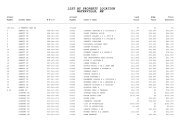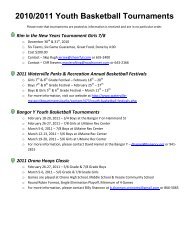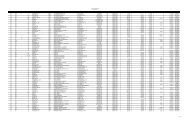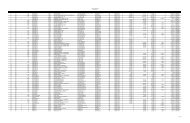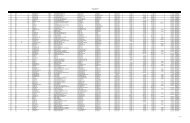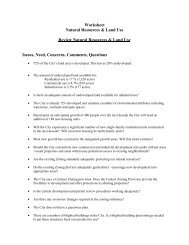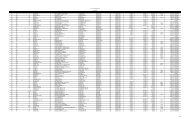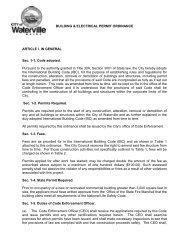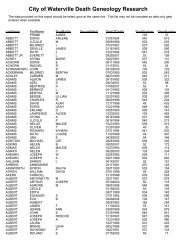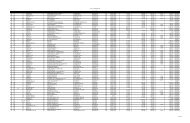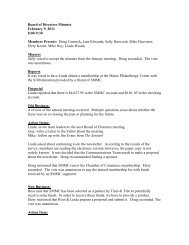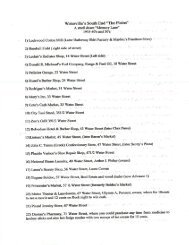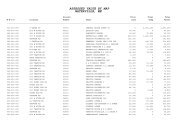Airport Master Plan 2012 - City of Waterville
Airport Master Plan 2012 - City of Waterville
Airport Master Plan 2012 - City of Waterville
Create successful ePaper yourself
Turn your PDF publications into a flip-book with our unique Google optimized e-Paper software.
Currently, the <strong>Airport</strong> pavement conditions can be summarized as follows:<br />
Table 1.5<br />
<strong>Airport</strong> Pavement Conditions<br />
Designation Condition Comment<br />
Runway 5-23<br />
Fair to Good<br />
Moderate longitudinal cracking, some transverse and<br />
randomly oriented shrinkage cracking<br />
Runway 14-32 Very Poor Extensive shrinkage cracking<br />
Taxiway “A” Fair to Good Longitudinal paving lane joint cracking<br />
Taxiway “B” Fair Numerous cracks with vegetation growth<br />
Taxiway “C” Fair Shrinkage cracking<br />
Taxiway “D” Excellent Reconstructed in 2007<br />
Taxiway “G” Fair Moderate lane joint and shrinkage cracking<br />
Taxiway “H” Fair Moderate lane joint and shrinkage cracking<br />
The condition <strong>of</strong> the bituminous pavement is generally fair to good over the entire length <strong>of</strong> Taxiway “A”<br />
which runs parallel to RW 5-23. The most prevalent distress is in the form <strong>of</strong> moderate severity,<br />
longitudinal paving lane joint cracking. Transverse shrinkage cracking also exists, along with some<br />
localized patch repairs that have been made over time.<br />
There is very little spalling, aggregate raveling, rutting, alligator cracking, or settlements that were<br />
evident due to heavy loading, unsuitable or variable subgrade materials, or frost conditions. No<br />
settlements resulting from drainage or utility trench crossings were observed. There does not appear to be<br />
significant rutting or settlements in the surface that would indicate severe structural deficiencies within<br />
the pavement section. Taxiway shoulders and safety areas appeared to be properly graded, structurally<br />
adequate, and well maintained.<br />
The most recent improvements to Taxiway “A” included an extension to the Runway 5 end, which was<br />
completed in 1987.<br />
Runway Safety Areas<br />
FAA runway safety standards require a 500-foot wide safety area that extends 1,000 feet beyond both<br />
ends <strong>of</strong> Runway 5-23. Initial inspection suggests the potential to meet this standard, however a full<br />
topographic survey is required to confirm actual grading conditions; this extensive survey effort was not<br />
included in the project scope <strong>of</strong> work. RSAs beyond runway ends consist <strong>of</strong> turf (Runway 5 end) or old<br />
bituminous pavement (Runway 23 end), are generally well graded, structurally stable, free <strong>of</strong><br />
obstructions, and have been maintained. Runway shoulders and lateral safety areas were properly graded,<br />
firm and well maintained, with no obstructions visible at the time <strong>of</strong> the inventory.<br />
Runway 14-32 has a 120-foot wide safety area along the entire runway length that also extends 240 feet<br />
beyond each end <strong>of</strong> the runway. Runway 14-32 safety areas beyond runway ends consist <strong>of</strong> turf and are<br />
generally well graded, structurally stable, free <strong>of</strong> obstructions, and have been well maintained.<br />
Runway shoulders and lateral safety areas were properly graded, firm and well maintained, with no<br />
obstructions visible at the time <strong>of</strong> the inventory.<br />
The <strong>City</strong> <strong>of</strong> <strong>Waterville</strong> Maine<br />
Baseline Conditions – Page 1-5<br />
<strong>Airport</strong> Solutions Group, LLC & The Louis Berger Group, Inc. December 2011



